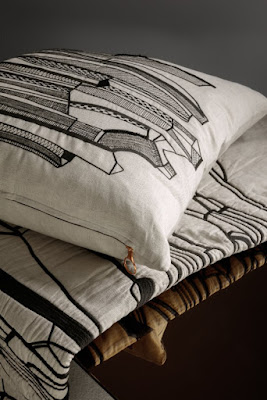 |
(L-R) Designers Matthew Miller, Christopher Bevans of DYNE and Ruchika Sachdeva of BODICE - winners of the
International Woolmark Prize 2017/2018 on January 9, 2018 in Florence, Italy.
(Photo by Elisabetta Villa/Getty Images for the Woolmark Company) |
 |
Matthew Miller’s winning collection has been described by Vogue Italia Editor-in-Chief
Emanuele Farneti as well-balanced with attractive price points. |
Winner of the Menswear 2017/2018 International Woolmark Prize was British designer Matthew Miller.
At a special
event during the Pitti Uomo menswear fair at Stazione Leopolda in Florence, Italy on 9th
January, Matthew’s winning collection was described by one of the judges Vogue
Italia Editor-in-Chief Emanuele Farneti as well-balanced with attractive price
points. “He showed a good combination between innovation, commercial viability
and pieces which will be worn by men on the street," said Emanuele.
By taking up the idea of “form follows function” inspired by
designer and philosopher Dieter Rams, Matthew added multifunctional elements
for different environments, such as the addition of the garment belt system
which acts as a way to turn the garment into an accessory in warmer climates. Miller treated wool in a variety of ways,
according to the IWS, including innovative treatments to create water resistant
fabrics and has erased the need for plastic fastenings by using recycled
material, such as waste marble. Using Australian Merino wool ranging from 17.5
to 20.5 microns, Matthew developed the inherent character of each piece as his design philosophy.
The event also saw womenswear winner Bodice and Innovation
Award winner DYNE awarded for their wool-rich collections.
 |
| Ruchika
Sachdeva of Bodice produced an elegant collection honouring Australian Merino wool and
the artisans of her country, India. |
Representing India, Pakistan
and the Middle East, Bodice by designer Ruchika Sachdevawas
was praised for her technique and the manufacturing
process.
Inspired by her grandmother who used to upcycle saris into quilts, Bodice addressed the issue of consumer waste in fashion with traditional techniques of recycling and cultural beliefs in the spiritual power of cloth to affect our well-being. Judge womenswear designer Phillip Lim described Bodice's collection as "completely thoughtful". "From the ingredients and dyes used all the way to the application and everything in between, her collection really represents a modern woman."
Collaborating with hand weavers and encouraging them to
take an unorthodox approach to traditional techniques, Ruchika Sachdeva
produced an elegant collection honouring Australian Merino wool and the
artisans of her country. Bodice also worked with Bio-Dye in Sawantwadi, central
India, which makes all colours from natural sources. The colour palette of navy
and forest green mixed with pink and green pastels contains natural dyes and
are safe for the skin - a nod to the ancient practices of Ayurveda. Completing
the label's holistic approach, Bodice sourced buttons from renewable sources of
coconut shell, seashell, and wood.
 |
The
collection of DYNE by Christopher Bevans comprised a technical snowboarding
wardrobe, complete with an NFC chip in the water-resistant wool jacket to track
users in avalanches and
ultimately bridge the gap between the brand and the
consumer. |
The Innovation Award powered by Future Tech Lab celebrates
the collection with the most innovative and creative wool fabrication, process
or development was awarded to DYNE by Christopher Bevans who according to the Woolmark Company demonstrated the most
exciting approach to help reduce its social and environmental footprint.
“For me he was definitely the leader in innovation,” said judge Miroslava Duma. “He really thinks about
technology every step of the way.”
Inspired by learning to snowboard in the 1980s - in a wool
bomber jacket - the DYNE collection comprises a
technical snowboarding wardrobe, complete with an NFC chip in the
water-resistant wool jacket to track users in avalanches and ultimately bridge
the gap between the brand and the consumer. DYNE describes itself as "liminal, as its garments are designed to operate on both sides of every threshold, and to break
the existing barriers of fabric, fit and function."
The collection, crafted from Merino wool ranging between 17
and 19.5 microns, includes zip-up hoodies, track pants, trench coats and
pullovers, treated so as to be water-repellent, with reflective overlays and inserts, functional pocket zips, laser-cut details and,
in certain instances, two-way stretch.
The menswear and womenswear winners each receives AU$200,000 to help support the development of their business. They will also receive ongoing industry mentor support, Woolmark certification for their winning collection and the opportunity to be stocked in some of the world’s most prestigious department stores and boutiques. DYNE receives AU$100,000 along with commercial opportunities.
Judges for the awards included Amber Valletta, Elizabeth Von Guttman, Emanuele Farneti, Julie Davies, Livia Firth, Liya Kebede, Miroslava Duma, Nonita Kalra, Phillip Lim, Riccardo Vannetti, Sarah Mower and Stuart McCullough along with representatives from the International Woolmark Prize retail partner network.
(Photos by Elisabetta Villa/Getty Images for the Woolmark Company)













































